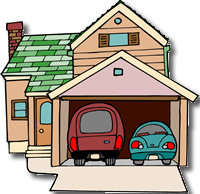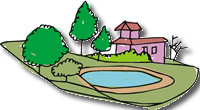| Improvements in transportation and changes in the economy led to the development of suburbs. Suburbs are inhabited areas located on the edge of a city.
City or Country  In the 18th and 19th centuries most people lived in the city or in a rural area.
People who lived in the city worked in the city. Everything they needed, from food to shelter, was found in the city. People who lived in the country usually grew their own food on farms and might travel to the city by wagon to sell what they grew. In the 18th and 19th centuries most people lived in the city or in a rural area.
People who lived in the city worked in the city. Everything they needed, from food to shelter, was found in the city. People who lived in the country usually grew their own food on farms and might travel to the city by wagon to sell what they grew.
Catch a Ride  With the development of trains and trolleys at the end of the 19th century, people could travel more quickly. The first suburbs developed along train and trolley lines. Now people could live outside of the city in places that were quieter and cleaner and still travel into the city to work. In fact, suburbs are sometimes called bedroom communities because people leave them during the day to go to work and return to them at night to go to bed! The invention of the car and the development of highways sped up the growth of suburbs. With the development of trains and trolleys at the end of the 19th century, people could travel more quickly. The first suburbs developed along train and trolley lines. Now people could live outside of the city in places that were quieter and cleaner and still travel into the city to work. In fact, suburbs are sometimes called bedroom communities because people leave them during the day to go to work and return to them at night to go to bed! The invention of the car and the development of highways sped up the growth of suburbs.
War's End  The end of World War II led to a boom in the growth of suburbs. Returning soldiers were ready to settle down and start families and the government provided low interest loans to help them buy houses. Between 1950 and 1956 suburbs grew by 46% and thousands of acres of farmland and forest were tuned into suburbs. The end of World War II led to a boom in the growth of suburbs. Returning soldiers were ready to settle down and start families and the government provided low interest loans to help them buy houses. Between 1950 and 1956 suburbs grew by 46% and thousands of acres of farmland and forest were tuned into suburbs.
| | | |
Changes in the Land  As suburbs grew, more and more land was developed, roads were built, wetlands were drained, fields were paved, and houses were built. All of these changes in the landscape led to declines in the numbers of some wildlife species. But developing farmland and forests for suburbs also led to gardens, bird feeders, lawns, bushes, trees, garbage cans, and fast food restaurants with dumpsters full of old food! Some species were better able to adapt to these changes in their habit and their numbers have stayed steady and in some cases increased. As suburbs grew, more and more land was developed, roads were built, wetlands were drained, fields were paved, and houses were built. All of these changes in the landscape led to declines in the numbers of some wildlife species. But developing farmland and forests for suburbs also led to gardens, bird feeders, lawns, bushes, trees, garbage cans, and fast food restaurants with dumpsters full of old food! Some species were better able to adapt to these changes in their habit and their numbers have stayed steady and in some cases increased.
Deer in the 'Burbs  The number of white-tailed deer has actually exploded in New Hampshire since the 19th century. It is estimated that there were
were less than 5,000 white-tailed deer in New Hampshire by the mid-1800s. Today the state's deer population is over 75,000. This growth in the deer population is due, in part, to the succession of farmland back to forest land and the development of farmland for suburban development. The number of white-tailed deer has actually exploded in New Hampshire since the 19th century. It is estimated that there were
were less than 5,000 white-tailed deer in New Hampshire by the mid-1800s. Today the state's deer population is over 75,000. This growth in the deer population is due, in part, to the succession of farmland back to forest land and the development of farmland for suburban development.
White-tail deer browse on plant matter they find on or near the forest floor. Healthy deer populations require new growth plants with good nutritional content. In an undisturbed forest, only so many deer can find enough browse to survive and deer populations naturally adjust to what the habitat can support.
When land is cleared or thinned out for development and trees are cut down, it opens up the canopy. This lets in more sunlight and new plants are allowed to grow providing fresh growth plants for deer to browse on. Homes in the suburbs often have gardens and bushes and trees that provide even more food for deer. With all this food available and the lack of any natural predators or hunting, deer populations in the suburbs can grow too quickly and cause problems for both humans and the deer.
 The deer in suburbs may suffer from malnutrition because the plants they are eating aren't providing the right nutrients. Disease can also spread more quickly in large populations. Increased deer populations in suburban areas also lead to more accidents involving deer and cars, damage to gardens and lawns, and increased human exposure to Lyme disease. The deer in suburbs may suffer from malnutrition because the plants they are eating aren't providing the right nutrients. Disease can also spread more quickly in large populations. Increased deer populations in suburban areas also lead to more accidents involving deer and cars, damage to gardens and lawns, and increased human exposure to Lyme disease.
|

 In the 18th and 19th centuries most people lived in the city or in a rural area.
People who lived in the city worked in the city. Everything they needed, from food to shelter, was found in the city. People who lived in the country usually grew their own food on farms and might travel to the city by wagon to sell what they grew.
In the 18th and 19th centuries most people lived in the city or in a rural area.
People who lived in the city worked in the city. Everything they needed, from food to shelter, was found in the city. People who lived in the country usually grew their own food on farms and might travel to the city by wagon to sell what they grew.  With the development of trains and trolleys at the end of the 19th century, people could travel more quickly. The first suburbs developed along train and trolley lines. Now people could live outside of the city in places that were quieter and cleaner and still travel into the city to work. In fact, suburbs are sometimes called bedroom communities because people leave them during the day to go to work and return to them at night to go to bed! The invention of the car and the development of highways sped up the growth of suburbs.
With the development of trains and trolleys at the end of the 19th century, people could travel more quickly. The first suburbs developed along train and trolley lines. Now people could live outside of the city in places that were quieter and cleaner and still travel into the city to work. In fact, suburbs are sometimes called bedroom communities because people leave them during the day to go to work and return to them at night to go to bed! The invention of the car and the development of highways sped up the growth of suburbs.  The end of World War II led to a boom in the growth of suburbs. Returning soldiers were ready to settle down and start families and the government provided low interest loans to help them buy houses. Between 1950 and 1956 suburbs grew by 46% and thousands of acres of farmland and forest were tuned into suburbs.
The end of World War II led to a boom in the growth of suburbs. Returning soldiers were ready to settle down and start families and the government provided low interest loans to help them buy houses. Between 1950 and 1956 suburbs grew by 46% and thousands of acres of farmland and forest were tuned into suburbs. As suburbs grew, more and more land was developed, roads were built,
As suburbs grew, more and more land was developed, roads were built,  The number of
The number of  The deer in suburbs may suffer from malnutrition because the plants they are eating aren't providing the right nutrients. Disease can also spread more quickly in large populations. Increased deer populations in suburban areas also lead to more accidents involving deer and cars, damage to gardens and lawns, and increased human exposure to Lyme disease.
The deer in suburbs may suffer from malnutrition because the plants they are eating aren't providing the right nutrients. Disease can also spread more quickly in large populations. Increased deer populations in suburban areas also lead to more accidents involving deer and cars, damage to gardens and lawns, and increased human exposure to Lyme disease.